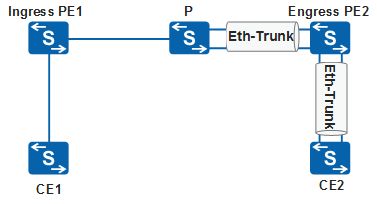(Optional) Configuring Flow Label-based Load Balancing
Context
Flow label-based load balancing enables Layer 2 virtual private network (L2VPN) data flows to be forwarded along different paths based on flow labels.
In an L2VPN scenario shown in Figure 1, the interfaces connecting the P device and PE2 as well as connecting PE2 and the CE are added to Eth-Trunks. Service flows from the same L2VPN use the same inner private label and outer public label. If label-based load balancing is used, the service flows cannot be load balanced along links in an Eth-Trunk because the service flows have the same hash factor. Flow labels can solve this problem. Ingress PE1 distributes a flow label to each service flow to uniquely identify this service flow. This flow label is stored in the innermost layer in the label stack on Ingress PE1. Egress PE2 can pop out flow labels. After flow labels are assigned, the P device and Egress PE2 can load balance flows in an Eth-Trunk based on the flow labels.

Currently, only the following techniques support flow label-based load balancing in an L2VPN scenario: static virtual circuit (SVC) and Martini virtual leased line (VLL), dynamic pseudo wire emulation edge-to-edge (PWE3), and Martini virtual private LAN service (VPLS)
Procedure
- Run system-view
The system view is displayed.
- Run interface interface-type interface-number
The interface view is displayed.
- Run mpls l2vpn flow-label { both | send | receive } [ secondary ] [ static ]
Flow label-based load balancing is enabled.

Flow label-based load balancing can be enabled only when any of the following conditions is true:
- The receive parameter is configured on the local PE, and the send parameter is configured on the remote PE.
- The send parameter is configured on the local PE, and the receive parameter is configured on the remote PE.
- Both the send and receive parameters are configured on the local and remote PEs.
The secondary parameter indicates that flow label-based load balancing takes effect only for the secondary PW on the interface. If you do not specify secondary parameter, flow label-based load balancing takes effect only for the primary PW on the interface.
If static is configured, the flow label-based load balancing capability is statically configured. After this keyword is specified, the PEs at two ends of a PW directly distribute flow labels without negotiating whether the flow label capability is enabled on each other. For dynamic PWs, if static is not configured, the flow label-based load balancing capability of the local end is negotiated by the remote end. For static PWs, the flow label-based load balancing capability is statically configured, irrespective of whether static is configured.
If the static flow label-based load balancing configuration does not match on both ends, the device discards packets carrying a flow label, causing packet loss.
